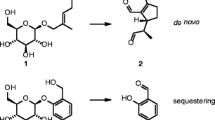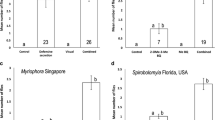Abstract
A mixture of defense compounds (benzaldehyde, benzoyl cyanide, benzoic acid, mandelonitrile, and mandelonitrile benzoate), found commonly in cyanogenic polydesmid millipedes, was identified in the non-cyanogenic millipede Niponia nodulosa. These compounds were major components in 1st–4th instars, but were absent in older instars and adults. Extracts of older instars and adults contained 1-octen-3-ol, 2-methyl-2-bornene, E-2-octen-1-ol, 2-methyl-isoborneol, and geosmin; these compounds were minor components in 1st–4th instars. This ontogenetic allomone shift may be explained by the high cost of biosynthesis of polydesmid compounds from L-phenylalanine being offset by their potency in protecting the insect during fragile and sensitive growth stages. However, as the cuticle hardens in older juveniles (5th, 6th, 7th instars) and adults, this allows for a switch in defense to using less effective and less costly volatile organic compounds (presumably microbial in origin) that are ubiquitous in the millipede’s habitat or are produced by symbiotic microbes and may be readily available through food intake or aspiration.




Similar content being viewed by others
References
Aldrich JA (1988) Chemical ecology of the heteroptera. Annu Rev Entomol 33:211–238
Bodner M, Raspotnig G (2012) Millipedes that smell like bugs: (E)-alkenals in the defensive secretion of the julid diplopod Allajulus dicentrus. J Chem Ecol 38:547–556
Cho IH, Kim SY, Choi H-K, Kim Y-S (2006) Characterization of aroma-active compounds in raw and cooked pine-mushrooms (Tricholoma matsutake Sing.). J Agric Food Chem 54:6332–6335
Dickschat JS, Martens T, Brinkhoff T, Simon M, Schulz S (2005) Volatiles released by a Streptomyces species isolated from the north Sea. Chem Biodivers 2:837–865. doi:10.1002/cbdv.200590062
Dionigi CP, Miillie DF, Spanier AM, Johnsen PB (1991) Spore and geosmin production by Streptomyces tendae on several media. J Agric Food Chem 40:122–125
Duffey SS, Underhill EW, Towers GHN (1974) Intermediates in the biosynthesis of HCN and benzaldehyde by a polydesmid millipede, Harpaphe haydeniana (Wood). Comp Biochem Physiol 47B:753–766
Eisner T, Alsop D, Hicks K, Meinwald J (1978) Defensive secretion of millipedes. In: Bettini S (ed) Arthropod venoms, handbook of experimental pharmacology, vol 48. Springer, Berlin, pp 41–72
Engels E, Engels W, Luebke G, Schroeder W, Francke W (1993) Age-related patterns of volatile cephalic constituents in Scaptotrigona postica Latr (Hymenoptera, Apidae). Apidologie 24:539–548
Fischer G, Schwalbe R, Moeller M, Ostrowski R, Dott W (1999) Species-specific production of microbial volatile organic compounds (MVOC) by airborne fungi from a compost facility. Chemosphere 39:795–810
Gerber NN, Lechevalier HA (1965) Geosmin an earthy-smelling substance isolated from Actinomycetes. Appl Microbiol 13:935–938
Jensen SE, Anders C, Goatcher L, Perley T, Kenefick S, Hrudey S (1994) Actinomycetes as a factor in odour problem affecting drinking water from the North Saskatchwan River. Water Res 28:1393–1401
Kheyri H, Cribb BW, Merritt DJ (2014) The comparative morphology of epidermal glands in Pentatomoidea (Heteroptera). Arthropodan Struct Dev. doi:10.1016/j.asd.2014.04.004
Kovat E (1958) Gas-chromatographische Charakterisierung organischer Verbindungen. Teil 1: Retentionsindices aliphatischer Halogenide, Alkohole, Aldehyde und Ketone. Helv Chim Acta 41:1915–1932
Kuwahara Y, Ômura H, Tanabe T (2002) 2-Nitroethenylbenzene as natural products in millipede defense secretions. Naturwissenschaften 89:308–310
Kuwahara Y, Mori N, Sakuma M, Tanabe T (2003) (1Z)- and (1E)-2-Nitroethenylbenzenes, and 2-nitroethylbenzene as natural products in defense secretions of a millipede Thelodesmus armatus Miyosi (Polydesmida: Pyrgodesmidae. Jpn J Environ Entomol Zool 14:149–155
Kuwahara Y, Shimizu N, Tanabe T (2011) Release of hydrogen cyanide via post-secretion Schotten-Baumann reaction in defensive fluids of Polydesmoid Millipedes. J Chem Ecol 37:232–238
Leal WS, Panizzi AR, Niva CC (1994) Alarm pheromone system of leaf-footed bug Leptoglossus zonatus (Heteroptera: Coreidae). J Chem Ecol 20:1209–1216
Lovell RT, Sackey LA (1973) Absorption by channel catfish of earthy-musty flavor compounds synthesized by cultures of blue-green algae. Trans Am Fish Soc 102:774–777
Lovell RT, Lelana IY, Boyd CC, Armstrong MS (1986) Geosmin and musty-muddy flavors in pond raised channel catfish. Trans Am Fish Soc 115:485–489
Martin JF, McCOY CP, Greenleaf W, Bennett L (1987) Analysis of 2-methylisoborneol in water, mud, and channel catfish from commercial culture ponds in Mississippi. Can J Fish Aquat Sci 44:909–912
Mills OE, Chung S-Y, Johnsen PB (1993) Dehydration products of 2-methylisoborneol are not responsible for off-flavor in the channel catfish. J Agric Food Chem 41:1690–1692
Mondor EB, Baird DS, Slessor KN, Roitberg BD (2000) Ontogeny of alarm pheromone secretion in pea aphid, Acyrthosiphon pisum. J Chem Ecol 26:2875–2882
Mori N, Kuwahara Y, Yoshida T, Nishida R (1994) Identification of benzaldehyde, phenol and mandelonitrile from Epanerchodus japonicus Carl (Polydesmida: Polydesmidae) as possible defense substances. Appl Entomol Zool 29:517–522
Murakami Y (1993) Dipropoda. In: “List of wild animals in Japan (5)”, list of wild life in Japan (nonvertebrate part), (the environmental protection agency of Japan, ed.). Natural Environment Research Center, Tokyo, pp 95–102 (in Japanese)
Noge K, Kimura H, Abe M, Becerra JX, Tomogami S (2012) Antibacterial activity of 4-oxo-(E)-2-hexenal from adults and nymphs of the heteropteran, Dolycoris baccarum (Heteroptera: Pentatomidae). Biosci Biotechnol Biochem 76:1975–1978
Norton RA (1998) Morphological evidence for the evolutionary origin of Astigmata (Acari: Acariformes). Exp Appl Acarol 22:559–594
Ômura H, Kuwahara Y, Tanabe T (2002) 1-Octen-3-ol together with geosmin: new secretion compounds from a polydesmid millipede, Niponia nodulosa. J Chem Ecol 28:2601–2612
Pasteels JM, Grégoire J-C, Rowell-Rahier M (1983) The chemical ecology of defense in arthropods. Annu Rev Entomol 28:263–289
Prudic KL, Noge K, Becerra JX (2008) Adults and nymphs do not smell the same: the different defensive compounds of the giant mesquits bug (Thasus neocalifornicus: Coreidae). J Chem Ecol 34:734–741
Raspotnig G, Krisper G, Schuster R (2005) Ontogenetic changes in the chemistry and morphology of oil glands in Hermannia convexa (Acari: Oribatida). Exp Appl Acarol 35:47–58
Raspotnig G, Kaiser R, Stabentheiner E, Leis H-J (2008) Chrysomelidial in the opisthonotal glands of the oribatid mite, Oribotritia berlesei. J Chem Ecol 34:1081–1088
Shimano S, Sakata T, Mizutani Y, Kuwahara Y, Aoki J (2002) Geranial: the alarm pheromone in the nymphal stage of the oribatid mite, Nothrus palustris. J Chem Ecol 28:1831–1837
Shinohara K (1999) Life of a Japanese millipede, Niponia nodulosa. Insectarium 18:82–86 (in Japanese)
Taira J, Nakamura K, Higa Y (2003) Identification of secretory compounds from the millipede, Oxidus gracilis C. L. Koch (Polydesmida: Paradoxomatidae) and their variation in different habitats. Appl Entomol Zool 38:401–404
Takada W, Sakata T, Shimano S, Enami Y, Mori N, Nishida R, Kuwahara Y (2005) Schloribatid mites as the source of pumiliotoxins in Dendrobatid frogs. J Chem Ecol 31:2403–2415
Wood N, Snoeyink V (1977) 2-Methylisoborneol, improved synthesis and a quantitative gas chromatographic method for trace concentration producing odor in water. J Chromatogr 132:405–420
Author information
Authors and Affiliations
Corresponding author
Rights and permissions
About this article
Cite this article
Kuwahara, Y., Ichiki, Y., Morita, M. et al. Chemical Polymorphism in Defense Secretions during Ontogenetic Development of the Millipede Niponia nodulosa . J Chem Ecol 41, 15–21 (2015). https://doi.org/10.1007/s10886-014-0536-8
Received:
Revised:
Accepted:
Published:
Issue Date:
DOI: https://doi.org/10.1007/s10886-014-0536-8




